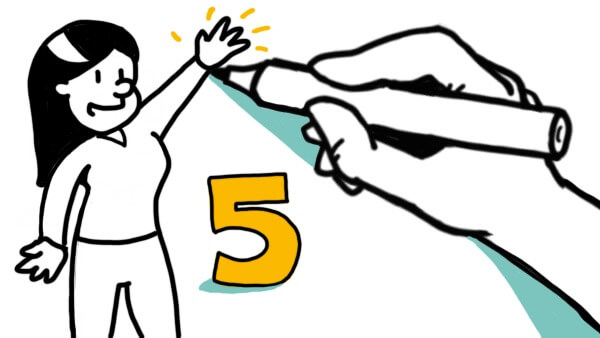Five Advantages of Whiteboard Storytelling

What is it about whiteboard video that makes it so effective? At TruScribe, we can answer that question in a variety of ways. It is, after all, what we do. But in this piece, we decided to zero in on five of the key strengths of whiteboard video. These are the elements that allow us to make engaging, retainable content, video after video. And they share one thing in common: contribution to strong, memorable storytelling. Let’s get into it.
Bring Everything in Sync
The first way that whiteboard video optimizes storytelling is through the principle of synchronization. With images drawn in sync with your voiced script, there’s a one-to-one relationship between what your viewers see and hear.
That image-narration relationship is crucial to engagement and retention. Since the brain gives preferential treatment to visual information, your images must synchronize directly with your narration to ensure full engagement.
Poor synchronization, whether from related imagery appearing at the wrong time compared to the script, or resulting from an attempt to synchronize unrelated images to your script, can distract viewers to the point of missing your message.
Unique Use of a Human Element
The second advantage of whiteboard visual storytelling comes from the human hand drawing the images in frame. The artist’s hand is a focal tool. It keeps your audience engaged through both its continuous motion. Your mind tracks unconsciously and through our natural inclination to seek out and follow human forms.
Still images, or traditionally-animated art, cannot drive engagement in this way. Without the focal point whiteboard provides with the human hand, the eye is either undirected or overstimulated. This can be fine for dozens of video applications. But for strong communication, hand-drawn designs will always promote the highest level of engagement with your message.
Simplicity Wins the Day
Engagement paves the way for retention. And a discussion of retention is a great jumping-off point for the third strength of whiteboard storytelling: the use of simple designs. Providing easy, quick comprehension for viewers, simple designs allow us to tell your story clearly and effectively.
By avoiding ornamentation and excessively intricate designs, simple visuals create engagement without engendering distraction; your viewers will enjoy and understand the visuals that complement your spoken message. And they wone be so absorbed by the image’s complexity that their minds tune out your narration.
This advantage applies to any video topic. But it gains additional salience for concepts that are more complicated or otherwise difficult to communicate. If your topic seems “dry” or highly technical, simple designs can be the antidote to potential viewer disengagement. With the right script and corresponding, simple images, you’ll earn and maintain your audience’s attention. And you will increase their retention of your message after your video is over.
The Right Narration Brings it Together
The fourth major advantage of whiteboard storytelling comes from the principle of voice. When you select a narrator, you’re choosing your message’s delivery method. Does your topic require a serious, measured voiceover, or is it better suited to an upbeat, lighthearted delivery?
At TruScribe, we provide clients seeking voiceover recommendations with a variety of choices, ensuring that their narrator is just the right messenger. And it’s not just the selection that will boost your voiced storytelling—we utilize a phone patch to bring our clients right into the recording session for their video.
This means that, in addition to the collaboration afforded to you by whiteboard in script and imagery, you’ll be able to fine-tune your voice actor’s performance to get just the right read for your message.
The collaborative nature of whiteboard storytelling is a theme throughout the creation of your video, and is a major underlying factor in the medium’s ability to transmit your message. The script that will be read by your voice actor will only proceed with your signoff, and the same is true for the voice actor, the images, and any extras you might need—let your production team know if you need a digital insert, for example, and we’ll include it.
Visual Storytelling is Compelling
Finally, there’s a way that whiteboard video’s storytelling ability goes above and beyond that does not spring from the medium’s design principles—at least, not directly.
Simply put, whiteboard video is underutilized.
Not everyone is familiar with this type of video, and that’s great news for your whiteboard story.
Want your video to stand out? Make a whiteboard video, and it will! While the internet is saturated with video, far too much of that saturation comes from talking-head videos, traditional animation, and other non-whiteboard videos.
Key Takeaways
The human hand, strong synchronization, simple designs, and great audio will engage your viewer continuously, and on top of that, you’ll have the advantage of novelty. Whiteboard is growing in popularity and use, but not so much that you won’t surprise and entertain viewers with a storytelling approach they’ve encountered rarely (if ever).
Whiteboard is a kind of storytelling that combines the best of the best at every level. The script combines the best of a client’s intent with the best skills of experienced copywriters, ensuring that your language transmits your message with the highest efficacy. Seasoned, highly talented artists craft the images crafted to support your scrip. And you approve everything prior to filming.
The human hand, drawing those images in synchronization with your voiced script, creates an attractive focal point to keep viewers zeroed in on your message throughout the video. And whiteboard’s simple, easily-followed style ensures that those images provide clarity and understanding in every frame.
Best of all, it’s a type of video that will almost certainly surprise and excite viewers. Whiteboard is a collaborative, fine-tuned form of storytelling. Research proves the principles of whiteboard video can promote engagement and retention rates. Take advantage of these benefits, and you’ll quickly see your organization’s storytelling reach new heights.
